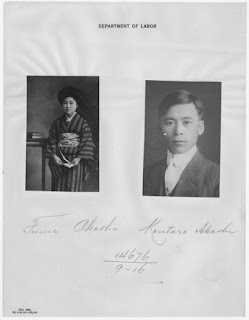Movie Monday: "Picture Bride," a film by Kayo Hatta
Wikimedia Collection
Hatta, Kayo. "Picture Bride," starring Kido Yuki, Takayama Akira, and Tamlyn Tomita, 1995.
It was by chance I happened upon “Picture Bride” at the library and was
moved to rent it. A riveting historical drama, "Picture Bride" depicts the life of a young Japanese immigrant woman working on the sugar cane fields in Hawaii during
the early 1900s. It shows how both characters used
deception to improve their chances of sealing the arranged marriage. Photography innovated the “picture bride”
system that initially relied on written letters alone or face-to-face meetings.
This film provides a solid script for strong performances that make the film particularly
moving. Lead actress Kudo Yuki gives picture bride Riyo the emotional
expressions that capture the apprehension and exhaustion a newly
arrived city girl experiences under field conditions. Actor Takayama
Akira ably expresses the hard life and defeatist mentality many
bachelor field hands experienced under the Gentleman's Agreement of 1907 and
prejudicial labor relationships. Finally, Tamlyn Tomita supports the
leads with her capable performance as a strong young
picture bride who must take on the roles of mother and mentor. One important aspect is that the cast are all capable Japanese
and Japanese-American actors, a novel circumstance given the recent
controversial casting choices in 2015 Hollywood.
When
Riyo (Kudo) first arrives at the immigration office on the shores of
the territory of Hawaii, she meets her husband for the first time, a
field hand (Takayama) almost two decades her senior. This fact, not shown
in the youthful photo he sent, sets up tensions from the start. The various hardships the two
newlyweds face include prejudicial ethnic conflict with white
overseers, labor conflicts with fellow Filipino field hands, as well
as the appeal of gambling as a downtime activity. Couple this with the relationship built on lies and the film contains plenty of tension and conflict. The challenges
these characters face will illuminate an almost forgotten historical
exchange network that greatly disrupted immigration to the United
States.
One
of the strongest aspects of this film is the human element that makes
it so relatable to a variety of viewers. Many of us can relate to the
class challenges of trying to get ahead in a tough work and social
environment, particularly when it seems like the paychecks are never
quite enough. Viewers may relate with the ethnic conflicts that
plague both historic societies and today. For me, this film made me
realize how blessed I am in my own life, particularly the great
physical toil these characters face each and everyday, and how they
manage to find positives.
Overall,
this film is a great peek into the historic condition of “picture
brides” under the Gentleman's Agreement of 1907. Not only
does it depict the ethnic conflicts Filipinos and Japanese field
workers faced, but also the different ethnic hierarchies that native
Hawaiians felt in relation to the Anglo landowners and European (Portuguese) overseers.
While the film does slip into too much pathos at times,
the narrative does manage to express an accurate depiction, perhaps
less intense than some authentic experiences, of Japanese immigrants under an
inherently prejudicial legal and social system. If you’re a fan of
historical dramas, this may be the film for you. Please post comments or suggestions below, and what films you'd like to see reviewed in future posts.
Purchase "Picture Bride" or stream via Netflix here.
Historical Notes for discussion in the comments:
- Ethnic interrelationships and labor: Anglo and Euro owners vs. laboring minority; labor vs labor between Filipinos and Japanese
- Labor
conflicts, the company store, $1 fee for lack of work, $. 65/day and $300
to go back to Japan
- Asian, mainly Japanese and Filipino actors cast in the film, Japanese language used instead of English (think Sayuri/Memoirs of a Geisha)

No comments:
Post a Comment